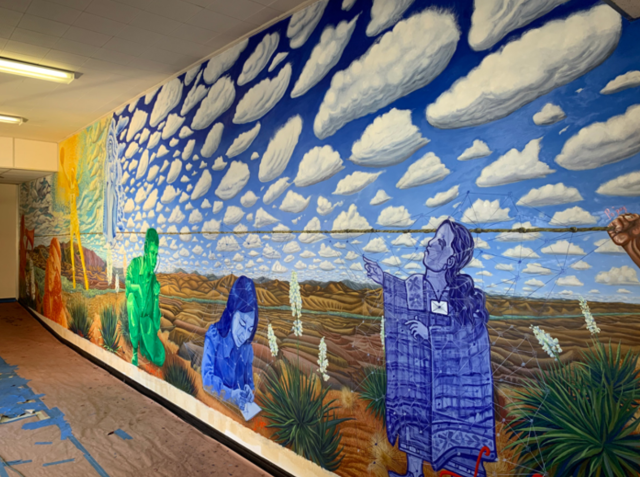
Taylor Spence, Can You Hear IT? (installation view) 2020, oil on marouflaged canvas, 120″x480″, University of New Mexico, Department of Information
Taylor Spence
I am a historical artist and public historian in the process of reconciling myself to my inheritance of violence and trauma as the descendant of settlers on the Front Ra[n]ge of the Rocky Mountains. Mine is a project of decolonization, the basis of which is the awareness that I do not and cannot have a permanent home on this continent. The aimed-for end result is liberation from the white, cis, settler entrapment of needing to justify, make excuses, and approbate denial.
My project began as an effort to quiet the sense of disquiet I experienced as a child in Oregon and Wyoming. I had not yet identified this anxiety as my queer wisdom speaking. The first means of expression I chose was painting. I won a Fulbright and earned a Master’s degree. After several years of this work, I realized I needed to learn more about the history of this continent, and so I earned a doctorate and became a researcher and writer of American history. My first book traces the lineage of a white settler way of thinking about resources, land, and belonging, what one might label white settler nationalism, to the border between the United States and British North America in the decades after the Revolution. Simultaneously, I began to grapple with the traumatic legacies of these actions in my own family and by extension the settler nation. I began my learning about Indigenous Americans’ histories and experiences, including that the notion of intergenerational trauma is highly contested, even as it feels very real to me.
Traditionally, history paintings coalesced consensus narratives. Think Leutze’s Washington Crossing the Delaware. What can history painting do in a post-consensus society? Any replacement narrative has to serve decolonization and the deconstruction of the exceptionalist edifice by bringing to light the injustices, highlighting the hypocrisy, but also revealing the resistance, all of which have made the nation. The digital space offers a discursive interface to help in these processes. On-line dossiers serve as alternatives texts to supplement and dialog with analog visual productions. They enable archives to be presented and scrutinized, stories to be fleshed out and digested, and arguments for significance to be marshalled and debated. History painting can no longer presume viewers’ complicity. It has to engage, propose, and teach.